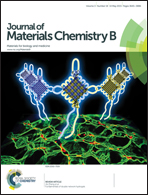Pickering high internal phase emulsion-based hydroxyapatite–poly(ε-caprolactone) nanocomposite scaffolds†
Abstract
Biocompatible, biodegradable and bioactive nanocomposite (NC) scaffolds with well-defined interconnected porous structures have attracted increasing attention in bone tissue engineering. In this work, we develop a facile method to fabricate poly(L-lactic acid)-modified hydroxyapatite (g-HAp)–poly(ε-caprolactone) (PCL) NC porous scaffolds by solvent evaporation based on water-in-dichloromethane (W/O) Pickering high internal phase emulsion (HIPE) templates, which are stabilized using g-HAp nanoparticles. The resultant porous scaffolds demonstrate interconnected and rough pore structures, which can be adjusted readily by varying g-HAp nanoparticle concentration, PCL concentration and the internal phase volume fraction. Moreover, the investigation of mechanical properties and in vitro biomineralization activity shows that the Young's modulus, compressive stress and bioactivity of the fabricated porous scaffolds are significantly enhanced upon increasing the g-HAp nanoparticle concentration. In addition, in vitro drug release studies of the porous scaffolds using ibuprofen (IBU) as a model drug show that the loaded IBU displays a sustained release profile. In vitro cell culture assays confirm that mouse bone mesenchymal stem cells can adhere, spread, and proliferate on the porous scaffolds, indicating that the porous scaffolds are biocompatible. All these results suggest that the fabricated g-HAp–PCL NC scaffolds have a promising potential for bone tissue engineering application.



 Please wait while we load your content...
Please wait while we load your content...